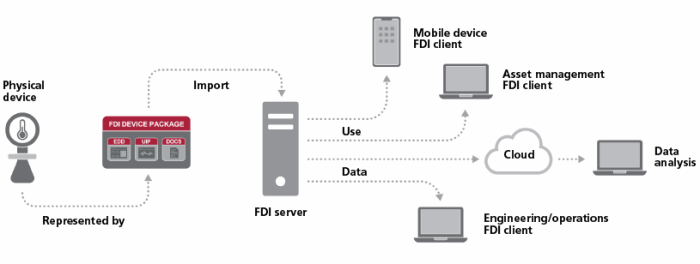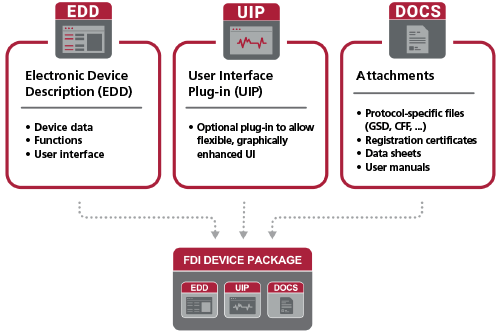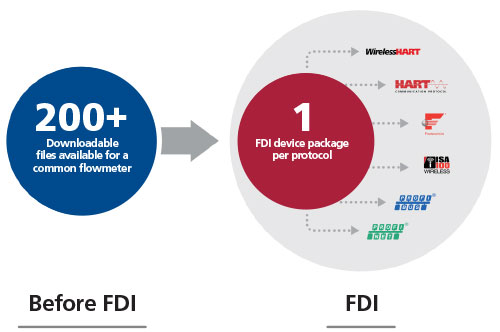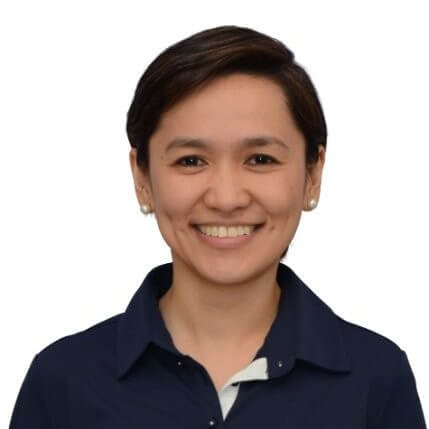
FDI combines the best features of EDDL and FDT packages.
Historically, differing asset monitoring devices, even if mounted on the same installation, might have very different ways of sending their data or configuration methods. Such a situation leaves project teams in a bind—do they stick with only one type of sensor, potentially eliminating their ability to use devices that are a better fit, or do they support multiple host technologies and increase the knowledge, custom configuration, and workload necessary each time they want to add sensing equipment?
Fortunately, there is now a mechanism that can help just this kind of situation. Field Device Integration (FDI) provides a common method that technicians can use to manage all the new devices being added as asset management programs grow. It is compatible with all host systems, and how it works is the topic of an article by Anna Veleña in the October issue of InTech, FDI Certification Enables Smoother Digital Transformation.
What is FDI?
“FieldComm Group is a global, standards-based, nonprofit member organization focused on digital open standards in the process industries. It has collaborated with industry foundations and suppliers like Emerson to develop FDI, an internationally standardized solution for process automation devices and system integration. A single FDI device package includes the device definitions, user interface plug-ins, certificates, and useful documentation. This information simplifies integration with field devices and FDI-enabled plant, enterprise, and cloud-based host systems. It also simplifies the selection, installation, and configuration of all field devices.”
One of the first objectives of FDI was to create a bridge between Electronic Device Description Language (EDDL) and FDT Device Type Manager (FDT/DTM), two incompatible device management software types that did much the same thing, but in different ways. Instrumentation and host system manufacturers tended to prefer one or the other, forcing users to learn both.

FDI packages provide fast access to protocol-specific files, registration certificates, data sheets, and manuals.
FDI solved much of that problem, but as originally published, it left much latitude for how manufacturers implemented it. FDI registration tightens up that latitude, which makes it easier on end users. Anna explains,
“As more manufacturers enable this [FDI] support, users will have access to a wider range of devices and functionality in their device manager applications. However, because manufacturers can choose which individual features to implement on their FDI host systems, it is possible that some applications will support certain elements of FDI but not others. To get the full benefits of FDI, standards organizations are supporting FDI-registered applications. FDI-registered hosts have implemented all the FieldComm Group’s specifications and passed a rigorous testing process to ensure that required features are supported by the software.”
Leveraging FDI to Support All Devices
The article shows how FDI solves many problems, for example by enabling easier personnel training and providing improved cybersecurity. Technicians don’t have to scour manufacturers’ sites to look for a critical file on an acoustic monitor because with FDI, a single package delivers everything necessary for integration.

Instead of scouring the Internet for hundreds of necessary files, users can simply download a single FDI package.
As support for FDI grows, so, too, will the number of devices a plant needs to monitor. Emerson’s AMS Device Manager is not only FDI-registered, but also supports thousands of devices, allowing you to monitor everything in the plant from a single instance, while simplifying installation and improving interoperability.
How are you handling asset monitoring in your plant? Is it “one size fits all,” or are you still working the hard way? Visit the Asset Management Software pages at Emerson.com. You can also connect with other maintenance and reliability engineers at the Emerson Exchange 365 community.





